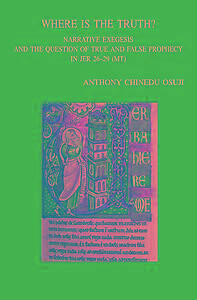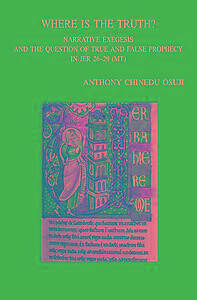
- Afhalen na 1 uur in een winkel met voorraad
- Gratis thuislevering in België vanaf € 30
- Ruim aanbod met 7 miljoen producten
- Afhalen na 1 uur in een winkel met voorraad
- Gratis thuislevering in België vanaf € 30
- Ruim aanbod met 7 miljoen producten
Zoeken
Where Is the Truth?
Narrative Exegesis and the Question of True and False Prophecy in Jer 26-29 (Mt)
Ac Osuji
€ 76,00
+ 152 punten
Omschrijving
This book takes a point of departure from what the author considers to constitute the important elements in any exegetical exercise; an interaction of three elements which are the text, the reader and the interpretive key. The text studied is Jer. 26-29(MT), the interpretive key is the narrative method. The interaction of the text with the reader, using the narrative method as the hermeneutical key is aimed at discovering what the text says from a theological point of view. So far in the history of research in the book of Jeremiah, except of course in the very recent times, historical questions have dominated, and many authors would doubt the applicability of the approaches with synchronic presumptions to the book. And so, the book of Jeremiah has remained for the most part, described either as a conglomeration of disparate unconnected elements, or a product of ideological juxtapositions that do not exhibit any literary or theological intention, or even pieces of texts chanced together by redactional happenstance. Consequently, works and commentaries on the book though with different accents, are still united in the goal of discovering the diverse origins of the different disparate units, or detecting the ipsissima verba of the prophet (if any). However, armed with tools for narrative exegesis, we could still, in a derived sense, notice a flow of story, a narrative logic in this block which begins with the prophet's preaching in chapter 26, through the tensions raised in 27 and dramatized in the direct duel of 28 between Jeremiah and Hananiah and finally Jeremiah's own vision of peace and the conditions on which the latter is possible in 29. The narrative reading of the four chapters therefore provides the scriptural basis for asking relevant questions concerning the theological problem of true and false prophecy which we identify to be the major theological theme in the block under study.
Specificaties
Betrokkenen
- Auteur(s):
- Uitgeverij:
Inhoud
- Aantal bladzijden:
- 465
- Taal:
- Engels
- Reeks:
- Reeksnummer:
- nr. 214
Eigenschappen
- Productcode (EAN):
- 9789042920842
- Verschijningsdatum:
- 14/07/2010
- Uitvoering:
- Paperback
- Formaat:
- Trade paperback (VS)
- Afmetingen:
- 160 mm x 239 mm
- Gewicht:
- 771 g

Alleen bij Standaard Boekhandel
+ 152 punten op je klantenkaart van Standaard Boekhandel
Beoordelingen
We publiceren alleen reviews die voldoen aan de voorwaarden voor reviews. Bekijk onze voorwaarden voor reviews.











